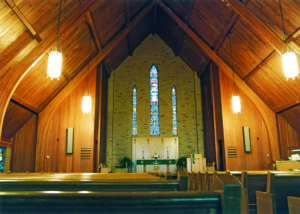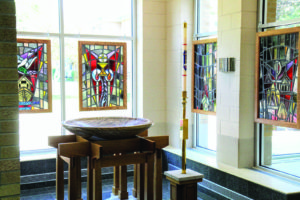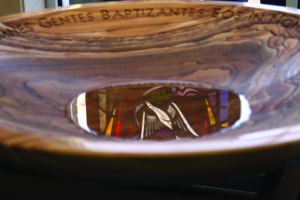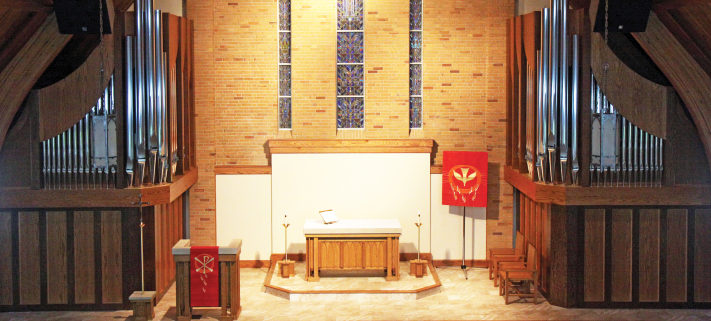Renovation: Luther Prep, Watertown, Wisconsin
Fifty years ago, the chapel on the Watertown campus was the worship gem in the WELS worker training system. It was a newly-built, neo-gothic structure with a fine neo-baroque Schlicker pipe organ of modest size. The organ, dedicated on March 14, 1963, was supported by a fine acoustical environment. It led the robust singing of the student body for decades. The sound and sheer volume of the singing gave me and my classmates goose bumps the first time we attended chapel as freshmen at Northwestern College. The Watertown chapel served up life-giving truth and life-long memories to thousands of called workers in WELS.
Gradually, the rest of the WELS worker training campuses caught up with—and surpassed—the chapel at Watertown. Michigan Lutheran Seminary reconfigured her old gym into a chapel/auditorium with good acoustics and a moveable 180-degree seating pattern. Wisconsin Lutheran Seminary installed a Martin Ott pipe organ and would later redo the entire chapel, earning a design award.1 Martin Luther College worshiped for decades in an auditorium until the New Ulm campus was blessed in 2010 with the Chapel of the Christ.2 All of these chapel projects have been welcome upgrades to our worker training system. They are molding and shaping the next generation’s expectations for public worship in WELS. Our synod is richly blessed as a result.
Over the years, while other chapels were improved, the Watertown chapel began to show her age. It received some attention during the mid-1990’s at the time of amalgamation when Martin Luther Preparatory School and Northwestern Preparatory School were combined on the Watertown campus as Luther Preparatory School. At that time, a link was built between the Library-Science Building and the main Classroom Building. The size of the chapel immediately became an issue. LPS enjoyed the blessing—and significant challenge—of having more students than the chapel could hold. The solution was the installation of a large, sloped, carpeted balcony. The seating issue was solved, but the acoustics of the chapel were drastically altered. The organ’s voice was dampened and could barely be heard underneath the balcony. The students’ singing was significantly impacted…and not for the better.

Chapel Before
Since amalgamation, other chapel improvements were generally piecemeal and not carried out with a view toward the whole. The sound system was upgraded, but the controls remained in the sacristy. Large black speakers were at odds with the wood and glass of the room. Little white space-age looking speakers were installed under the balcony to try to accommodate the poor acoustics. New lighting was installed, but with a different fixture style and light intensity than the older fixtures. Pews were mixed, some from the original chapel, others installed post-amalgamation. The sacristy, really a storage room, remained untouched. During a visit in 2014 I was surprised to see that neither the room nor its contents had changed since college graduation back in 1993!
The genesis of the chapel project
The chapel project began as yet another minor improvement. The 1950’s blond wood laminate on the altar and pulpit was beginning to chip, bubble up, and peel away. It was originally envisioned that the “new” pulpit would utilize parts of the old and generally look like the old. The laminate of the reredos was in good shape, but the altar itself needed significant work. The initial proposal for a new but not very different pulpit and altar was estimated at $2,000-4,000. The chapel had no baptismal font. The initial proposal kept a “?” behind the baptismal font, noting that it would be good for “both symbolic and practical use.” It was thought that these items could be provided as a graduating class gift.
Along with cosmetic furniture repair, another urgently needed improvement was being discussed. The pipe organ had received no major maintenance since it was installed in 1963. The organ was inspected by Dr. Edward Meyer in the fall of 2008. His report noted many maintenance issues. The organ chamber had accumulated 55 years of dust. The organ needed to be re-leathered. The keyboards needed minor repairs. More ominous, however, were the “long-range” issues. The air lines needed to be replaced. The entire electrical system needed to be upgraded. The cloth-covered, low-voltage wires were a fire waiting to happen.
Dr. Meyer’s report also addressed serious acoustical issues:
When the organ was acquired, the chapel interior did not have the 1995-balcony, nor did it have carpet in any area. The organ was designed for the space and it served well in that environment. It was bright, strong, transparent, and supported the hearty singing of 300+ men easily. The room acoustics have been drastically altered since that time…. The balcony overhang hinders sound from reaching the worship space beneath it. The soft floor covering near the altar and in front of the first pews absorbs a generous amount of sound—both vocal and instrumental. The result is an organ that is no longer fully capable of carrying out its originally intended roles as it once had.
Dr. Meyer’s report then listed five acoustical suggestions to enhance the room. The report concluded with a recommendation to expand the tonal variety of the organ. The additional stops would have cost another $150,000. In short, Dr. Meyer’s report gave the LPS administration about $190,000 of things to think about—not including the acoustical recommendations. It became obvious that the chapel needed more than new laminate on the furnishings. It needed a complete overhaul.
“Let’s do it right”
With a proposal in hand for partially-new chancel furnishings, with another proposal for organ maintenance under discussion, with acoustical enhancements being proposed that would alter the look of the chapel, and with the 150th anniversary of the Watertown campus on the horizon, the LPS administration decided to seek some independent counsel. With two sons enrolled at LPS, I was asked to serve as chapel consultant. President Crass expressed a strong desire to “do things right.” The next year was filled with questions of what was “right” for the Watertown campus, her students, and the church body she serves. These conversations were a blessing. The results of these conversations we commend to the Lord of the Church and the constituency of WELS.
The first question the project had to answer concerned the organ. The organ had longevity on its side. No one really wanted to be done with it. But the maintenance issues would need to be taken seriously. If we performed all needed maintenance and brought the electrical issues up to code, the total cost would have been well-north of $100,000 and would have cannibalized over half of the project’s original budget. That’s a lot of money to invest in an organ that everyone knew was inadequate for the post-1995 space. Should we just live with it? Opt for an electric organ? What about installing a used pipe organ? How about a minor expansion of the current instrument? All these options were explored and eventually rejected. None of them were quite right for LPS.
The organ issue bled into larger issues with the room itself. What about the acoustics? It would be poor stewardship to sink money into the organ while the room remained acoustically unfit. The acoustical question raised the issue of flooring, a mix of carpet and tile. (This then led to another issue: asbestos!) Study of flooring options raised the practical question of pew removal and reinstallation. Should we really reinstall pews that were in worse shape than the chancel furnishings that started the project in the first place? The administration of LPS became convinced that this was the right time to opt for new pews as part of ongoing campus maintenance. The rest of the project would be paid for through the synod-wide thank offering that was underway to celebrate the campus’s 150th anniversary.
The school administration hoped that something could be finished for the 150th anniversary year. The first element completed was the new baptistry. I proposed the baptistry concept to the administration after preaching for chapel. I noticed the beautiful tower with six windows just to the east of the main entrance doors. (The only thing in the tower, however, was a donated kitchen table on which students placed their books and backpacks.) About the same time, Prof. Robert Bock visited Trinity, Waukesha for the baptism of his granddaughter. During coffee hour, he commented that there were six stained glass windows from the pre-1995 chapel in a crate in the basement of the cafeteria. About the same time, my son came home from LPS one Friday eager to show a video of an international student being baptized at a chapel service. I noticed that a stainless-steel bowl was used for the water. At Taste of Ministry Day, I found out that the Scharf family’s popcorn bowl was used for the baptism.

The baptistry, “a theologically rich center point”
A plan came together. The six stained glass windows from the pre-1995 chapel windows were framed in wood and hung in the six clear glass windows. The mix of stained and clear glass balances color and light. The six windows are hung thematically: Two windows picture the Word of God, two the Church, and two the sacraments. Instead of catching dust in the cafeteria basement, these windows now catch light in the center of the campus. The used kitchen table was replaced with a beautiful wooden baptismal base designed by Massmann Studios. The base was a labor of love by Matthew Staude, a NPS alumnus. His craftsmanship and attention to detail are a beauty to behold. The popcorn bowl has been replaced with a substantial stone basin inscribed with the Latin words BAPTIZANTES EOS IN NOMINE PATRIS + FILII + SPIRITUS SANCTI, a nod to the classical heritage of the campus. It is hoped that the baptistry, underwritten by a gift from the NWC Alumni Society, will serve as a theologically rich center point on the campus for the next 150 years.

Stone basin with Latin from Mt 28:19
Meanwhile, the organ plank in the project began to take on a new life. Once again, the school administration expressed a wish to do things “right.” LPS certainly does things “right” when it comes to training future church workers in general—and church musicians in particular. LPS trains more students in organ than any other high school in America. WELS needs these young musicians. The chapel organ, used several hours a day by multiple musicians, needed to become a higher priority. When issues of cost were discussed, it was noted that the school had, in the past, spent significant resources on items deemed important to the school’s mission (especially the athletic fields). The organ portion of the project was handled much like it would be in a WELS parish. The organ wasn’t paid for out of the school’s budget or the LPS150 special offering for chapel renovation and tuition assistance. It was paid for by additional gifts from the Lord’s people who hold in their hearts a special love for LPS’s music program. The organ was dedicated with a plaque thanking God for the teaching ministries of Prof. and Mrs. Franklin Zabell. Prof. Zabell now sings with the choirs of heaven. Mrs. Zabell continues to teach a new generation of organists to lead choirs on earth.
After several interviews, the organ contract was awarded to Berghaus Pipe Organ Builders of Bellwood, IL. The new instrument used almost all the pipes of the old Schlicker organ, added several new ranks of pipes from an Italian Ruffati instrument that Berghaus had recently acquired, as well as a few ranks of new pipework. The new Berghaus instrument still has two manuals, but now has 33 ranks of pipes (1871 total pipes) and 33 stops. Its expanded tonal resources are ideal as a teaching instrument. Its robust tone fills the chapel without being overpowering. The new instrument inspires singing and has the gravitas to truly lead the assembly’s song. The organ footprint now takes up both sides of the chancel. The Great and Pedal divisions are to the left where the old Schlicker pipes stood. The Swell division is to the right where the old sacristy/storage room stood.
The organ now speaks directly into the sanctuary, rather than being enclosed in a room that opened only into the chancel. Two more benefits were realized as a result of the organ case’s new footprint: 1) Two additional stained glass windows, previously hidden in the pipe room and sacristy, are now visible to worshipers. 2) The chancel steps have been reconfigured (widened and deepened) so that choirs can now sing from the steps with the organ providing direct support.
Repairs to pulpit and altar were the initial focus of the chapel project. Attention to these primary furnishings expanded to include: altar, pulpit/ambo, processional cross stand, paschal candle stand, pastoral chairs and tables, candle bases, and hymn boards—all fashioned out of white oak instead of blonde laminate. These furnishings were designed by Massmann Studios and crafted by Matthew Staude. The pulpit and altar are both topped with stone, truly worthy of a school of the prophets. Ours is an enduring message!
Doing the project right meant not doing some things at all, for now. We did not enhance the sound system or improve the lighting. Why? No more money in the budget. It was decided that these two elements could be handled at a later date as resources become available.
The Watertown campus has been a blessing to WELS for 150 years. May she serve us well for another 150 years! May the Lord pour out his blessing upon those who preach, play, and sing—that our children would be inspired to tell the children’s children the praiseworthy deeds of the Lord!
By Aaron Christie
Pastor Christie serves at Trinity, Waukesha, WI, where he plans worship and plays organ and piano. He is a member of the Commission on Worship and the Institute for Worship and Outreach, a presenter for the Schools of Worship Enrichment, and chairs the Hymnody Committee of the WELS Hymnal Project. He holds the Master of Church Music degree from Concordia University Wisconsin and served as a consultant for the Luther Prep renovation project.
Renovation pointers learned from the LPS chapel project
These pointers apply to any renovation project.
- Focus not only on the initial impetus for renovation. Keep an eye on what the proposed renovation does to the entire worship space.
- Keep your ear on acoustical issues. Good acoustics can easily be destroyed. The new carpet under your feet will look nice and sound terrible. Spend the money to get an acoustical study done early in the project. It is money well spent. Opt for floor coverings that both look nice and sound nice. (Hint: tile)
- Don’t cut corners. Instead, view your renovation as one chapter of your sanctuary’s entire lifetime. Accomplish what you can with excellence. Leave the rest for a separate phase that can be done when God provides the resources. One project, well-done, often serves as an encouragement for additional upgrades in the future.
- Don’t be afraid to enlist professional consultants and/or worship leaders in WELS. They are here to serve. An outside set of eyes and a lifetime of different experiences often prove helpful to building committees that are seeing things up-close and very personal.
Worship Conference Resources
Various items are available at the Worship Website: workshop handouts, service folders, repertoire lists, presentation files (both PowerPoint and PDF versions), and photos. A double CD of musical highlights should be available in December – a great gift-giving option. Check NPH for the title “A Mighty Fortress.”
1 See Worship the Lord #21, September 2006, available in the WTL online archives. The LPS chapel dedication worship folder is available at https:/worship.welsrc.net/ download-worship/worship-the-lord-renovation-projects/. Numerous photos of the LPS project are at https://www.lps.wels.net/page/chapel-renovation-photo- gallery.
2 https://mlc-wels.edu/history/chapel-of-the-christ/
[fbcomments num=”5″]


